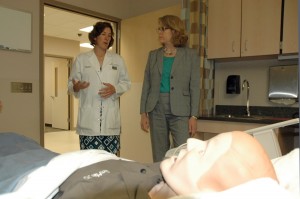
Noelle is one of the first patients that nursing students meet in their studies at the Beth-El College of Nursing and Health Sciences.
A woman of average height, weight, complexion and hairstyle, Noelle has a variety of medical issues ranging from minor to life threatening that can change in the blink of an eye, thanks to the miracle of technology and the work of faculty and AV technicians.
Noelle is one of five patients in residence at the new simulation laboratory in University Hall. The lab looks and feels like a hospital room with its extra wide doors, industrial strength furniture and soft-hued walls. It is intended to give students a realistic introduction to health care. Every clinical course taught at Beth-El will now include time in the simulation lab before students work in local medical facilities.
“This is the place to practice what we call high-risk, low-frequency medical events,” Lynn Phillips, instructor, Beth-El College of Nursing and Health Sciences, explained as she provided a tour of the simulation lab during an open house event this week. “You don’t want your first time seeing some of these things to be live.”
Noelle can take on any of twelve different personalities and a nearly endless array of medical challenges. In one scenario, Noelle is pregnant and the delivery of her baby causes massive hemorrhaging. In another, the baby is delivered breech and in yet another, Noelle experiences breathing problems. The combinations are nearly limitless as experienced faculty members working with AV technicians program Noelle to simulate real-life issues. Students are then evaluated on their responses and coached how they might improve.
But Noelle isn’t alone. A few feet from her bed lies a newborn baby who Phillips says can change from “a wonderful little baby with soft cries” to one who needs intubation before being transported to an intensive care unit. Three more simulated patients round out the patient family, including “Carl” who made his debut two years ago when Beth-El introduced courses taught via Cisco TelePresence.
The simulators are so realistic that simulated blood can gush from them. So can other bodily fluids as Beth-El faculty seek to make the patient experience realistic. Suction tubes on the wall above the patient’s bed are functional and students can calibrate oxygen airflow, and both prepare and administer medications. They can even use an electronic defibrillator to shock a patient during a simulated heart attack.
While the simulation lab places an emphasis on developing clinical skills, it also helps prospective nurses practice what Phillips refers to as “soft skills.” Examples include teaching nursing students to introduce themselves to the patient during shift change, to practice charting, receiving physician orders by telephone, or dealing with an argumentative patient. It’s all recorded in the name of learning.
The dream of Beth-El’s faculty for more than a decade, the simulation lab was under design for five years. Construction began in Jan. 2012, when faculty members were moved from their offices to make way. The project was completed this summer at a cost of more than $1 million. Gifts from the Colorado Health Foundation and the Caring for Colorado Foundation provided for the electronics, human patient simulators, and other equipment. Capital construction funds were provided by UCCS, according to Nancy Smith, dean, Beth-El College of Nursing and Health Sciences.

Leave a Reply